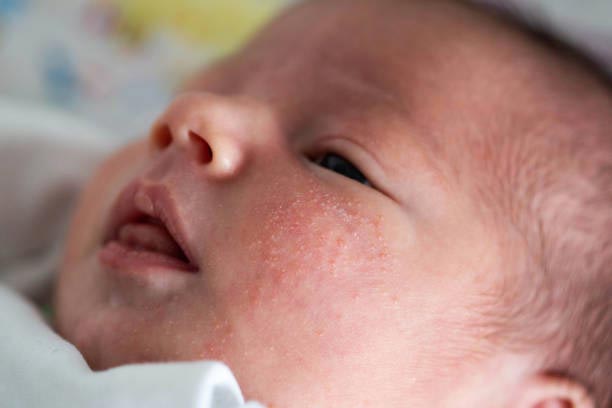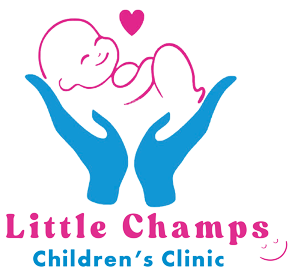Overview
Rashes are common among newborns and infants, often appearing within the first few weeks of life. While they can be concerning for new parents, most baby rashes are mild, temporary, and part of a baby’s skin adjusting to its new environment. Learning to recognize these rashes, understanding their causes, and knowing simple treatments can help parents keep their babies comfortable and calm.

Why do newborns develop rashes?
A newborn’s skin is delicate and sensitive, adjusting to the external environment after months in the womb. As a result, babies are prone to developing different types of skin reactions. Common causes include skin sensitivity, exposure to new fabrics, moisture, heat, and minor irritants from baby products.
What are the types of newborn rashes?
Here’s an overview of the most common newborn rashes:
Diaper rash
- Appearance: red, inflamed skin in the diaper area, sometimes with small bumps or blisters.
- Cause: moisture and friction from the diaper, prolonged exposure to urine or stool, or sensitivity to certain wipes or diapers.
- Treatment: keep the diaper area dry, change diapers frequently, and apply a barrier cream or ointment like zinc oxide.
Baby acne
- Appearance: small red or white pimples, typically on the face, especially the cheeks, nose, and forehead.
- Cause: maternal hormones or skin’s adjustment to the external environment.
- Treatment: generally clears up on its own without treatment within a few weeks. Avoid oily creams, and gently cleanse with water.
Milia
- Appearance: tiny white or yellow bumps, usually on the nose, cheeks, or around the eyes.
- Cause: blocked skin pores from undeveloped oil glands.
- Treatment: milia require no treatment and typically disappear on their own within a few weeks.
Cradle cap (seborrheic dermatitis)
- Appearance: yellow, greasy, or flaky scales on the scalp; may also appear behind the ears or on the eyebrows.
- Cause: overactive sebaceous glands, possibly due to maternal hormones.
- Treatment: gently massage the scalp with baby shampoo or mineral oil, and brush to loosen flakes. Avoid harsh scrubbing.
Erythema toxicum neonatorum (ETN)
- Appearance: small red patches with tiny white or yellowish pimples in the center, usually appearing on the chest, face, arms, or legs.
- Cause: unknown, though it is a common and harmless condition affecting up to half of all newborns.
- Treatment: no treatment is needed, as it typically resolves on its own within a few days to weeks.
Heat rash (prickly heat)
- Appearance: small red bumps that can appear in skin folds, such as the neck, underarms, or diaper area.
- Cause: hot or humid weather, or when babies are overdressed.
- Treatment: dress the baby in lightweight clothing, keep them cool, and avoid heavy blankets.
Eczema (atopic dermatitis)
- Appearance: dry, red, itchy patches, often on the face, scalp, or arms.
- Cause: sensitive skin or family history of eczema, allergies, or asthma.
- Treatment: use gentle, fragrance-free moisturizers, bathe with lukewarm water, and avoid known irritants.
Symptoms to watch for
Newborn rashes usually aren’t cause for concern, but here are some symptoms to help identify and manage them:
- Red patches or bumps: often appear as tiny spots or blotchy patches that can spread.
- Dry, flaky skin: especially common in conditions like eczema or cradle cap.
- Raised, irritated skin: typically seen in diaper rash or baby acne.
- Peeling skin: newborns may experience harmless peeling, especially on hands and feet.
If a rash is persistent, seems to be causing discomfort, or is accompanied by fever, consult a pediatrician.
What are the best treatment options for newborn baby rashes
Most newborn rashes are treatable at home with simple care and attention:
- Keep skin clean and dry: gently cleanse the baby’s skin daily with warm water and a soft cloth, avoiding harsh soaps.
- Avoid irritants: use fragrance-free, hypoallergenic baby products, and choose soft, breathable fabrics for clothing and blankets.
- Use barrier creams for diaper rash: applying a zinc oxide-based diaper cream can help protect the skin from moisture.
- Moisturize dry areas: apply a gentle, baby-safe moisturizer to dry or sensitive areas to prevent itching and irritation.
- Maintain a cool environment: avoid overdressing the baby and keep the nursery at a comfortable temperature to prevent heat rash.
When to see a pediatrician?
While baby rashes are rarely serious, there are times when a healthcare professional should be consulted:
- If the rash spreads quickly or appears swollen, warm, or filled with fluid.
- If the baby develops a fever or shows signs of distress, such as excessive crying or difficulty feeding.
- If the rash doesn’t improve with home care after a few days or seems to worsen.
How to prevent newborn rashes?
There are several ways to prevent or minimize newborn rashes:
- Frequent diaper changes: change diapers often and use gentle, fragrance-free wipes.
- Keep skin hydrated: apply a baby-safe moisturizer to prevent dryness.
- Use soft fabrics: dress your baby in soft, cotton clothing and wash clothes in fragrance-free, hypoallergenic detergent.
- Avoid overheating: dress the baby in lightweight layers and avoid heavy blankets in warm weather.
Conclusion
Newborn baby rashes are a common experience and, in most cases, don’t pose a serious health concern. By recognizing the different types of rashes, understanding simple home treatments, and taking preventive steps, parents can help keep their baby’s skin healthy and comfortable. However, if a rash seems severe or causes discomfort, consult your pediatrician for guidance and care. Remember, your baby’s skin is delicate, and gentle care can make a big difference in managing and preventing rashes.
Articles
- The Impact of Nutrition on Children's Growth and Development
- The Benefits of Spending Time Outdoors for Children's Health
- The Ultimate Guide to Infant Feeding
- Establishing Healthy Sleep Habits for Your Baby
- Newborn Baby Rash Treatment In Vijayawada
- What is baby colic?
- Dengue Fever in Infants
- What do you need to know about chickenpox or varicella?
- What is common cold in children?
- What is whooping cough or pertussis in children?
- What is anemia in kids?
- What is influenza or flu n children?
